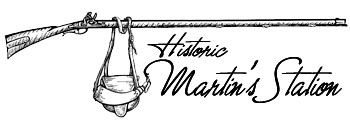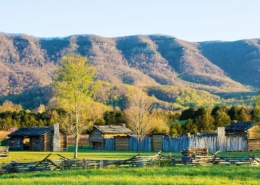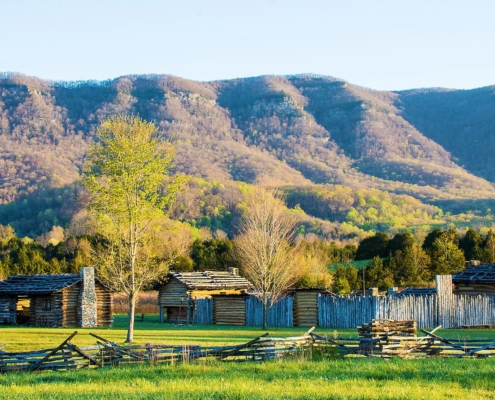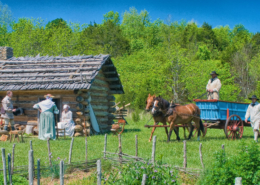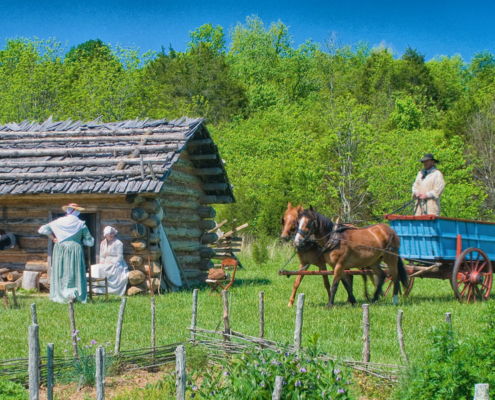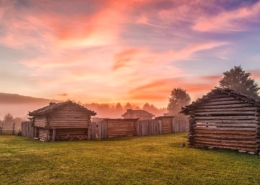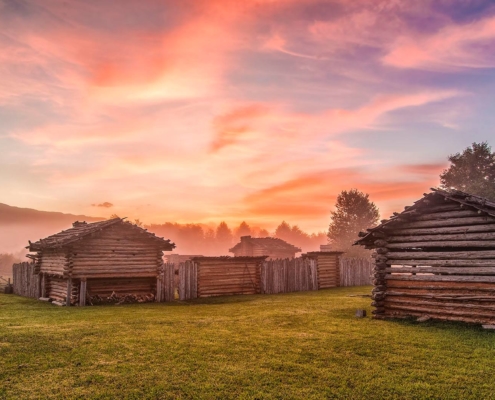The Wilderness Road
The Wilderness Road, first known as Boone’s Trace, is perhaps one of the most famous and significant pathways in all of American history. The Road played a vital role in early frontier life and westward expansion in the United States. The Road began as a buffalo trail made by the great herds that once roamed the hills of Central Appalachia. Cherokee and Shawnee warriors used it as a game trail and as a convenient pathway to launch raids on one another for many generations. The native name for the path was Athowominee, meaning “Path of the Armed Ones”.
Historians believe the first white colonist to record crossing the Cumberland Gap, and using at least a portion of what became the Wilderness Road, was a young man named Gabriel Arthur. Arthur was captured by Shawnee warriors in 1673. The Shawnee ultimately released him, and he reached present day Petersburg, Virginia on June 18, 1674 after what was no doubt an epic journey into the Wilderness and back again.
In 1750, the Loyal Land Company of Virginia launched an expedition seeking western frontier lands for potential settlement. The Crown granted the company upwards of 800 acres of western lands for this purpose. The man selected to head the expedition was Dr. Thomas Walker of Charlottesville in Albemarle County, Virginia.
Dr. Walker was an adventurous soul possessed of many talents. He would sally forth with a survey party of five companions, mounts, plenty of packhorses, hunting dogs, equipment, and provisions. Walker’s odyssey into the vast American backwoods began in April 1750. He traveled westward all the way to modern day Lee County, Virginia and through the Cumberland Gap. Walker and his party grew discouraged by the rough, mountainous region of southeast Kentucky and turned back before reaching what we now call the Blue Grass. Yet their efforts and report proved to be invaluable to those who would follow. He did not return home until July 13 of the same year.
During the journey, Dr. Walker kept a detailed diary, which survives today as a treasure of the American frontier that details these exciting days of early America. Walker holds the distinction of being the man who named the Cumberland Gap, the mountain pass that features so prominently in the history of American western settlement, folklore, song, and legend.
The year 1769 would prove to be a momentous year for the story of the road. That year two woodsmen made a friendship and association that would prove fortuitous. Joseph Martin, who was a friend of Dr. Thomas Walker, accepted a challenge from the good Doctor to attempt to settle in present day Powell Valley, Virginia. If Martin succeeded, he would be awarded 21,000 acres for his efforts. Another party of Longhunters happens by in May, bound for Kentucky hoping to find the gap in the mountains. They are led by Daniel Boone. The meeting of these two men, with their combined ambition to begin a new life, carved out of their “hunter’s paradise”, would change early American history.
Judge Richard Henderson and a board of trustees comprised of wealthy businessmen and civil servants from North Carolina form a new land company in 1775. They call themselves the Transylvania Company, which is Latin for “Land beyond the woods.” The audacious ambitions of these land speculators has been both condemned and admired. One thing is certain; historians agree that their efforts played a milestone in the settlement of Kentucky and the American West. Henderson, a shrewd man, surrounded himself with others who knew what they were about. He hired both Boone and Martin in the employ of the proposed Transylvania Colony. Martin would serve as entry taker & civil leader in Powell Valley. Boone would serve as chief guide & scout and civil leader on the Kentucky side of Cumberland Mountains.
In March of 1775, Henderson and Co. struck a bargain with the Cherokee nation at the Sycamore Shoals of Watauga River. At a huge gathering of Cherokee and backcountry settlers, Henderson’s associates and Cherokee Chiefs haggled over the price for 20-million of what is now the Commonwealth of Kentucky. Before the ink upon the purchase treaty was dry, Daniel Boone was sent forth by the Company to carve out a path to the purchased lands. Boone, with 30 road cutters began their guest from Long Island of Holston River (modern-day Kingsport, TN) they cut their way over Holston, through Moccasin Gap, Walker Ridge and into Powell Valley past Joseph Martin’s Station. After resting at Martin’s they continue on through the Gap and into Kanta-Ke. By April they arrive at a meadow on the south side of Kentucky River in modern day Madison County. They began labor on the capital of the new Transylvania Colony, which the inhabitants began to call Boonesboro. With these developments, as the War for Independence begins, the race for settlement takes flight.
The flow of travelers upon the Wilderness Road waxes and wans during the war years, yet heroic efforts continue; efforts that will prove to be invaluable to the development of the infant United States. It is estimated that approximately 200,000 to 300,000 hopeful settlers used the Wilderness Road the years 1775 to 1810. The old path more than proved itself to be the lifeline to a budding new nation.
These brief words can only be used to hopefully instill a hunger in the reader to learn more, much more about the rich and stirring story of America’s Road West.
